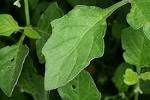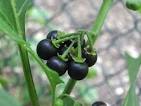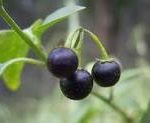Solanum nigrum
Uses
Hawaii: cooked leaves and branches eaten. India (Bombay Presidency): leaves and fruit eaten; (Deccan): herb eaten; (Rajasthan, western): leaves and fruit used a vegetable; ripe fruit eaten raw. Schultes & von Reis report young shoots are also eaten, Zululand (Ubombo district): leaves and berries eaten. China: leaves and fruits eaten.
Additional Information
- Name Authority:
- L.
- Vernaculars:
- Hawaii: Popolo. (India) Bombay Presidency, Ahmednagar district: Kangwani. Rajasthan (western) : Makol. Zululand: Ixabaxaba. English: Common Nightshade, Black Nightshade.
- Misc:
- Chemical composition (fruit, Chinese sample): Protein = 2.51%. Fat = 0.56%. Carbohydrate = 5.66%. Ash 1.19%. Leaves may contain a toxic element. Seeds may be above-average for angiospermous plants in the amino acids Alanine, Phenylalanine, and Threonine.







